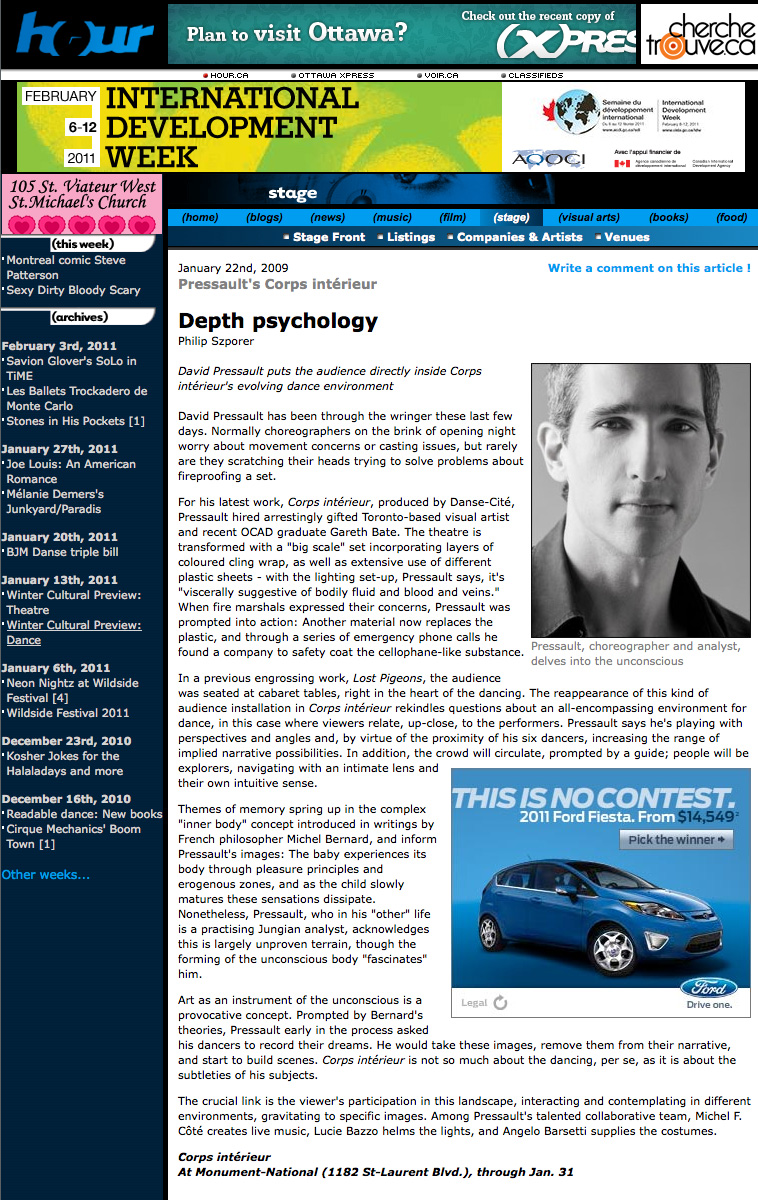Hour.ca, Montreal
"Pressault's Corps intérieur: Depth Psychology"
Philip Szporer,
Jan. 2009
(Featuring set design installation for Corps intérieur.)
Curtesy of the Hour.ca
Return to Press Menu | Read as Plain Text | View Website Source
Hour.ca, Montreal
"Pressault's Corps intérieur: Depth Psychology"
Philip Szporer,
Jan. 2009
(Featuring set design installation for Corps intérieur.)
Curtesy of the Hour.ca
Return to Press Menu | View Website Source
David Pressault puts the audience directly inside Corps intérieur's evolving dance environment
David Pressault has been through the wringer these last few days. Normally choreographers on the brink of opening night worry about movement concerns or casting issues, but rarely are they scratching their heads trying to solve problems about fireproofing a set.
For his latest work, Corps intérieur, produced by Danse-Cité, Pressault hired arrestingly gifted Toronto-based visual artist and recent OCAD graduate Gareth Bate. The theatre is transformed with a "big scale" set incorporating layers of coloured cling wrap, as well as extensive use of different plastic sheets – with the lighting set-up, Pressault says, it’s "viscerally suggestive of bodily fluid and blood and veins." When fire marshals expressed their concerns, Pressault was prompted into action: Another material now replaces the plastic, and through a series of emergency phone calls he found a company to safety coat the cellophane-like substance.
In a previous engrossing work, Lost Pigeons, the audience was seated at cabaret tables, right in the heart of the dancing. The reappearance of this kind of audience installation in Corps intérieur rekindles questions about an all-encompassing environment for dance, in this case where viewers relate, up-close, to the performers. Pressault says he’s playing with perspectives and angles and, by virtue of the proximity of his six dancers, increasing the range of implied narrative possibilities. In addition, the crowd will circulate, prompted by a guide; people will be explorers, navigating with an intimate lens and their own intuitive sense.
Themes of memory spring up in the complex "inner body" concept introduced in writings by French philosopher Michel Bernard, and inform Pressault’s images: The baby experiences its body through pleasure principles and erogenous zones, and as the child slowly matures these sensations dissipate. Nonetheless, Pressault, who in his "other" life is a practising Jungian analyst, acknowledges this is largely unproven terrain, though the forming of the unconscious body "fascinates" him.
Art as an instrument of the unconscious is a provocative concept. Prompted by Bernard’s theories, Pressault early in the process asked his dancers to record their dreams. He would take these images, remove them from their narrative, and start to build scenes. Corps intérieur is not so much about the dancing, per se, as it is about the subtleties of his subjects.
The crucial link is the viewer’s participation in this landscape, interacting and contemplating in different environments, gravitating to specific images. Among Pressault’s talented collaborative team, Michel F. Côté creates live music, Lucie Bazzo helms the lights, and Angelo Barsetti supplies the costumes.
Corps intérieur
At Monument-National (1182 St-Laurent Blvd.), through Jan. 31
